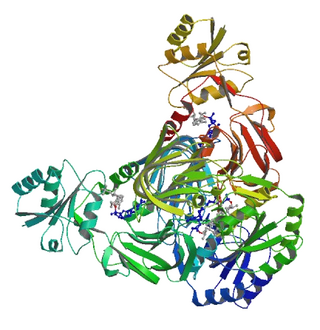
Galactose-1-phosphate uridyltransferase is an enzyme responsible for converting ingested galactose to glucose.

NAD+ kinase (EC 2.7.1.23, NADK) is an enzyme that converts nicotinamide adenine dinucleotide (NAD+) into NADP+ through phosphorylating the NAD+ coenzyme. NADP+ is an essential coenzyme that is reduced to NADPH primarily by the pentose phosphate pathway to provide reducing power in biosynthetic processes such as fatty acid biosynthesis and nucleotide synthesis. The structure of the NADK from the archaean Archaeoglobus fulgidus has been determined.

Sodium/potassium-transporting ATPase subunit alpha-1 is an enzyme that in humans is encoded by the ATP1A1 gene.

Sphingomyelin phosphodiesterase 1 (SMPD1), also known as acid sphingomyelinase (ASM), is an enzyme that in humans is encoded by the SMPD1 gene.

D-bifunctional protein (DBP), also known as peroxisomal multifunctional enzyme type 2 (MFP-2), as well as 17β-hydroxysteroid dehydrogenase type IV is a protein that in humans is encoded by the HSD17B4 gene. It's an alcohol oxidoreductase, specifically 17β-Hydroxysteroid dehydrogenase. It is involved in fatty acid β-oxidation and steroid metabolism.

Cathepsin E is an enzyme that in humans is encoded by the CTSE gene. The enzyme is also known as slow-moving proteinase, erythrocyte membrane aspartic proteinase, SMP, EMAP, non-pepsin proteinase, cathepsin D-like acid proteinase, cathepsin E-like acid proteinase, cathepsin D-type proteinase) is an enzyme.

N-acylglucosamine 2-epimerase is an enzyme that in humans is encoded by the RENBP gene.

Long-chain-fatty-acid—CoA ligase 1 is an enzyme that in humans is encoded by the ACSL1 gene.

Polypeptide N-acetylgalactosaminyltransferase 1 is an enzyme that in humans is encoded by the GALNT1 gene.

Protein NPAT also known as nuclear protein of the ATM locus is a protein that in humans is encoded by the NPAT gene.

Carbohydrate sulfotransferase 2 is an enzyme that in humans is encoded by the CHST2 gene.

CMP-sialic acid transporter is a protein that in humans is encoded by the SLC35A1 gene.

Dolichyl-diphosphooligosaccharide—protein glycosyltransferase subunit DAD1 is an enzyme that in humans is encoded by the DAD1 gene.

Protein OS-9 is a protein that in humans is encoded by the OS9 gene.

Galactose-3-O-sulfotransferase 2 is an enzyme that in humans is encoded by the GAL3ST2 gene.

2-hydroxyacylsphingosine 1-beta-galactosyltransferase is an enzyme that in humans is encoded by the UGT8 gene.

Carbohydrate sulfotransferase 11 is an enzyme that in humans is encoded by the CHST11 gene.

PKN3 is a protein kinase C-related molecule and thought to be an effector mediating malignant cell growth downstream of activated phosphoinositide 3-kinase (PI3K). It is thought that chronic activation of the phosphoinositide 3-kinase (PI3K)/PTEN signal transduction pathway contributes to metastatic cell growth and that PKN3 may mediate that growth.1

ADP/ATP translocase 3, also known as solute carrier family 25 member 6, is a protein that in humans is encoded by the SLC25A6 gene.

ADP/ATP translocase 2 is a protein that in humans is encoded by the SLC25A5 gene on the X chromosome.





















